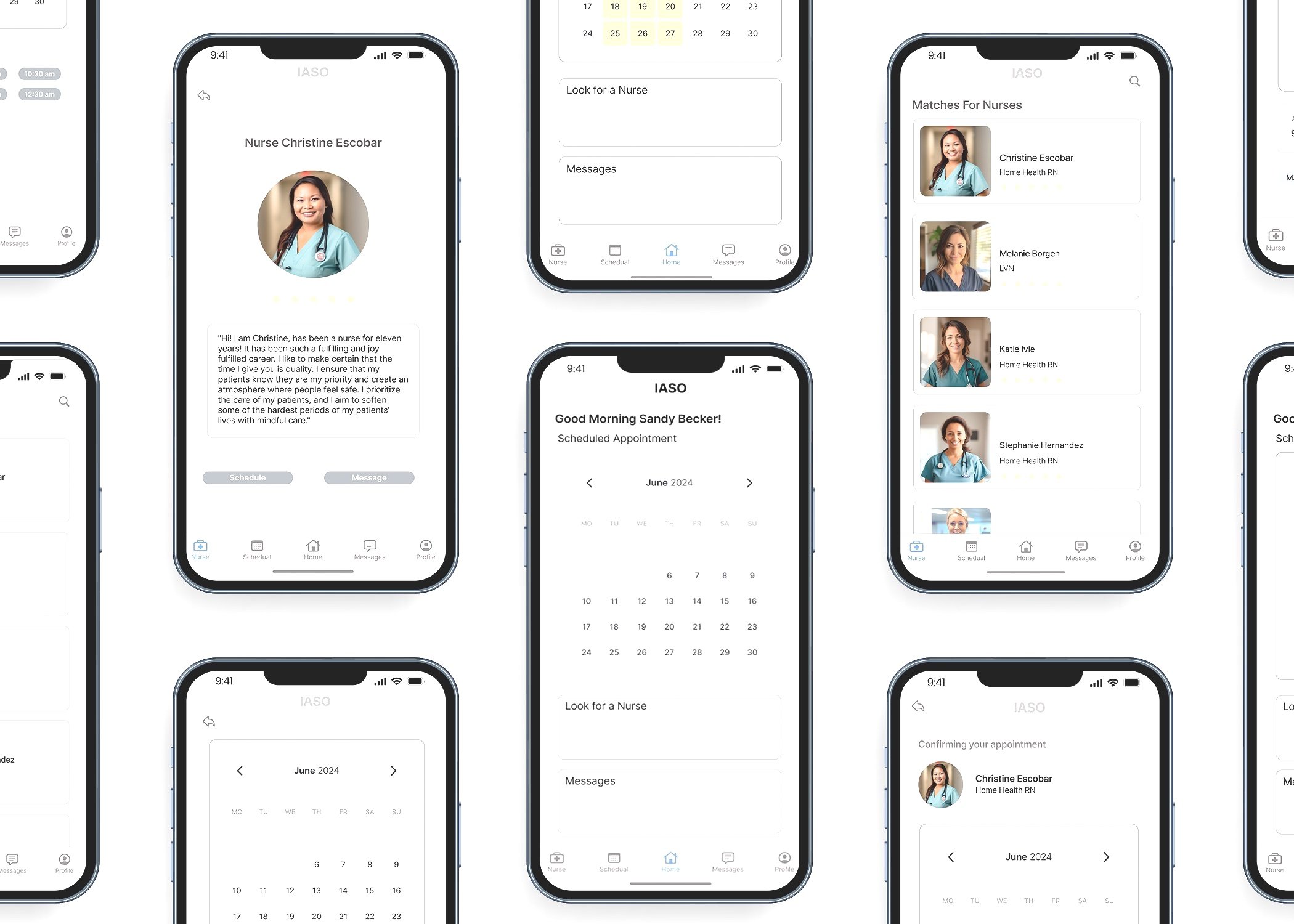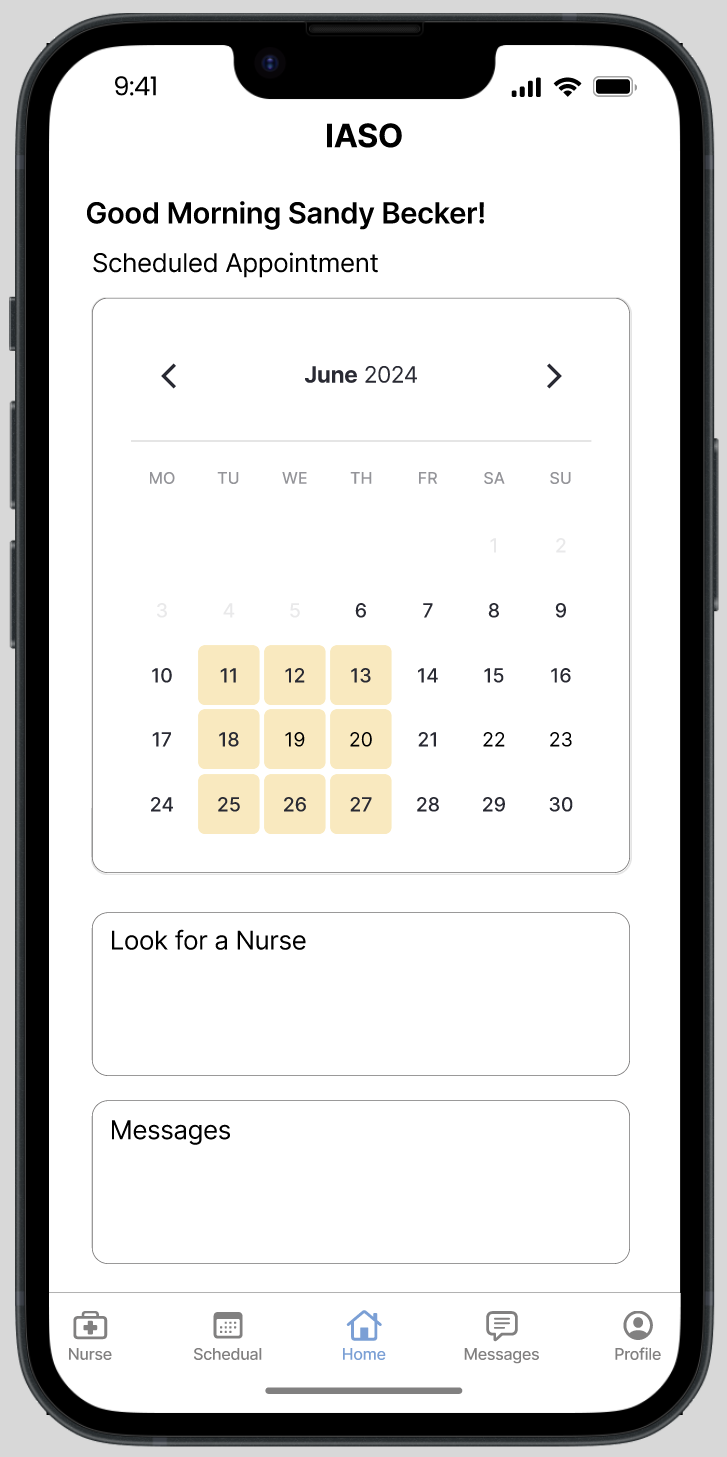
IAS0
Ux Case Study
IASO was the goddess of cures, remedies, and modes of healing.
The Problem
This app aims to simplify the process of finding a nurse for trusted home care. It connects individuals in need with nurses seeking flexibility in their work. By providing empathetic support and varied options, the app streamlines the home care experience for everyone involved.
Task Completion Demonstration
Scenario 1: You have been diagnosed with late-stage Lyme disease. Your body is not working in the way it should. You are in a constant state of pain. A doctor has told you that you need intravenous antibiotics; you need them three days a week, for about five weeks. He did not tell you where to get them, but they are time-consuming, and you are in so much pain that you are looking to do them at home. Find a nurse to administer your treatment.
Task 1: Find a nurse to administer your treatment.
Scenario 2: You have finally found someone you can trust and feel good about your decision. Schedule that nurse.
Task 2: Schedule that nurse.
Below I explain how I designed to solve for this task.
Ethnographic Research
Ethnographic research helps us understand the problem of the people we are trying to help. Through that research, I can build more accurate personas and scenarios. For this research, I interviewed seven people I knew who needed home care at some point. I also interviewed five medical workers and home care workers I personally know.
Patients Notes
Found looking for a nurse was complex and complicated.
Many people were unkind and lacked bedside manor.
They did not know which nurse to trust and wished they could see past patient experiences with the nurse.
They were already feeling poorly, they just wanted help.
Some even felt embarrassed by their fear and confusion.
Many were worried that the nurse wouldn’t be as clean as they wanted.
They wanted to feel safe and feel taken care of.
They felt sick and needed treatment but did not know who to go to or who to trust, and they wish it could have just been easier.
Many need treatment done a few times like, intervenes therapy, cleaning ports, redressing, wounds and cleaning, and so on.
Many where Lyme patients.
Has found many people in the health care system were not patient.
Nurse Notes
Found looking for a patient messy and to unofficial.
Many people were confused about what they needed the nurses need a more comprehensive file for home patients.
They wanted to make sure they were entering good homes where they were safe.
They wanted to have the ability to schedule themselves so that they had more control over the jobs they chose and how much they worked.
Most home care is done through home care companies.
Sometimes those companies don’t work well with specific needs.
Wanted to know who and what they were treating very clearly.
Looking for control and structure for themselves.
They would love travel nurse options.
Many were looking for different work options outside of the regular office system.
Personas
A persona is a representation of the typical user or group. The Norman group defines it as “a persona is a fictional, yet realistic, description of a typical or target product user. A persona is an archetype instead of an actual living human, but personas should be described as if they were real people.” This persona is compilation of the data found in the ethnographic research.
Patient
Sandy Becker
52
Borrelia miyamotoi (Lyme disease)
About Sandy
Sandy has had Lyme disease. She needs intravenous treatment three days a week for five weeks. She also has a port that has to be cleaned and cared for. She has had bad experiences with past health workers and wants a good experience during this scary and challenging time. She finds herself very worried about finding a nurse to administer her care. She is looking for someone who will be reliable, skilled, and can be trusted. She wants to ensure they are clean, which is one of her main concerns with her port and IV.
Behavioral Considerations
Does not feel good and has deficient energy.
Is worried because if a nurse messes up, it could be life-threatening.
Is prone to anxiety.
Wants to feel like she is well taken care of and put a ease.
Looking for an easier process because she is feeling overwhelmed.
Frusrations
Feels abandoned by the healthcare system.
Can’t find a home nurse to help her.
Having an issue with insurance.
Has looked for nurses through home-care companies, none have been helpful and just have left her more confused.
She feels desperate for help and like no one is listening to her.
Tasks
Find schedule a nurse.
Make sure the nurse is someone you can trust.
Book them for her six-week treatment.
Book a port cleaning.
Goals
She wants to find a trusted nurse to administer IV.
She needs to also find some that will clean and re-tape her pot every week.
She wants to schedule them easily.
She needs to find someone that she can trust that makes her treatment process easy.
“I don’t know how to get help and I don’t even know if I do find someone if they are even any good and it is scary.”
“Don’t feel well and I just need help and there is no one to help me this is so hard."
Nurse
Christine Escobar
34
Has been a nurse for 11 years
About Christine
Christine has been a nurse for eleven years. She finds her career very fulfilling and enjoys helping people. She really struggles with the fast pas energy of working in the office and the hard hours. Christine struggles to work in the traditional American healthcare system, rushes the healthcare workers, and is not looking out for the best interest of the sick. She would like to spend more quality time with her patients. Christine also wants to have more control over when and where she works. Christine is looking for more freedom and connection in her career.
Behavioral Considerations
A very dedicated worker.
Highly empathetic.
Has other interests outside of work that she wants to spend time on.
Very clean and detail-oriented.
Likes to know what she is getting into doesn’t like to go into things blind.
Frusrations
She feels that the American healthcare system rushes the healthcare workers and is not looking out for the best interest of the sick.
She feels like she is overworked.
Never gets to know and spend time with patients.
Would like more communication with the people she treats.
Misses out on travel and time with family.
Feels like all she does is work and lacks freedom in her life.
Is constantly being rushed because if the insurance system.
Works so much that she is missing connection in her life.
Tasks
Find and schedule patients.
Choose her schedule.
Make sure she wants to work with that person.
Needs to see a note on that person.
Accept a job.
Goals
She wants to find a healthy work-life balance.
She wants to see patients that she connects with.
She wants more freedom over her life and schedule.
Wants to help people genuinely.
“I am just really craving more freedom and control over my time.”
“I with I could have more communication with people that I see regularly so that I can know what is going ton to help them better.”
Senarios and Tasks
These scenarios were created to understand the tasks Sandy and Christine would need to solve. Plans and studies help focus and guide the designers on solving those problems for the user. They also help the usability testers get in Sandy and Christine’s mindset for testing.
Patient
Scenario 1: You have been diagnosed with late-stage Lyme disease. Your body is not working in the way it should. You are in a constant state of pain. A doctor has told you that you need intravenous antibiotics; you need them three days a week, for about five weeks. He did not tell you where to get them, but they are time-consuming, and you are in so much pain that you are looking to do them at home. Find a nurse to administer your treatment.
Task 1: Find a nurse to administer your treatment.
Scenario 2: You have finally found someone you can trust and feel good about your decision. Schedule that nurse.
Task 2: Schedule that nurse.
Scenario 3: You have some questions about how you should prepare for your treatment. Message your nurse.
Task 3: . Message your nurse.
Nurse
Scenario 1: You love caring for people, which is why you love being a nurse. However, the current system doesn’t allow for to spend the time she would with each patient. She long hours but has been yearning for more freedom and connection. You want more control over time and find patients that fit you and your schedule. Enter your schedule.
Task 1: Enter your schedule.
Scenario 2: You are eager to find patients that fit the work you are interested in. You have requests from potential patients. Find a patient that is the best fit for you.
Task 2: Find a patient that is the best fit for you.
Scenario 3: You have a few questions for the patient about their treatment before you book the. Message the patient.
Task 3: Message the patient.
Usability Testing
Paper Prototype
I always find that I learn the most from my paper prototypes, and this time was no different. During the first round of testing, I conducted five sessions and quickly realized that my tasks and scenarios needed fine-tuning. They were unclear, which resulted in user confusion during testing and made my design appear confusing as well. After taking note of this, I worked on clarifying the tasks to provide clearer guidance to the users. With the improved tasks, I proceeded to create my second paper prototype and conducted another round of usability testing. The results were much better, and users seemed to navigate through the design with less difficulty. However, I did notice some hesitation from the users regarding where to click. I believe this hesitation may have been influenced by the nature of using a paper prototype, which lacks the interactivity of a digital interface. Nonetheless, I gained valuable feedback from the second round of testing, which will be crucial for refining my design further.
Low Fidelity Prototype
I created my low fidelity prototype in Figma, focusing on leading the user through signifiers and natural mapping. After conducting 10 usability tests, I discovered several areas that required improvement. Initially, I had too many signifiers in places where users were not inclined to click, so I had to reevaluate their placement. Additionally, I realized the need to increase the size of the typography and enhance contrast to ensure better readability throughout the interface. Another significant change I made was removing the "directions" at the top of the screen, as users were not paying much attention to them anyway. A good design should be intuitive enough to guide users without relying on explicit instructions. Through these iterative usability tests, I refined my prototype and addressed the identified issues, resulting in a more user-friendly and efficient design.
High Fidelity Prototype
My final prototype was also made through Figma. In my final prototype, my goal was to create a clean, soft, and user-friendly experience. Throughout the process, I conducted around 10 tests, making small tweaks in the design. I removed unnecessary elements, like a line at the top and an unused arrow button, which caused confusion. By adhering to familiar conventions, I aimed to help users navigate effortlessly through the design. My focus was on leading users in an intuitive way, which led to a simpler and more streamlined design. As I made these simplicity changes, I noticed that users flowed through the app smoothly. The end result is something that I believe offers an easy and beautiful experience for the users.
Task Completion Walk Through
Scenario 1: You have been diagnosed with late-stage Lyme disease. Your body is not working in the way it should. You are in a constant state of pain. A doctor has told you that you need intravenous antibiotics; you need them three days a week, for about five weeks. He did not tell you where to get them, but they are time-consuming, and you are in so much pain that you are looking to do them at home. Find a nurse to administer your treatment.
Task 1: Find a nurse to administer your treatment.
Scenario 2: You have finally found someone you can trust and feel good about your decision. Schedule that nurse.
Task 2: Schedule that nurse.
1.This walk through solving tasks, one and two of Sandi‘s scenario. Here The user will click looking for a Nurse.
2. The user will first look for the nurse they want to schedule. This will be narrowed down but what they need and location.
3. Here they can read and see if this nurse will be a good fit. As well as check on her rating and see what other patients have said about Christine.
4. This screen will prompt the user to schedule to make an appointment.
5. This process is designed to flow as the user moves down through dates and times.
6. Once a date and time is chosen it will turn yellow in order to give feed back to the user showing what they selected.
7. Here the user can do a final check. The “done” button is blue in order to guide the users hand so they know how to submit.
8. Then the user will confirm that appointment.
9. Lastly, they will be back on the home screen, but now with the scheduled appointments visible in yellow.
Wrap up
Solving this complex problem has been a rewarding journey, and I am eager to explore it further. The healthcare domain brought many challenges, and understanding its intricacies was one of the hurdles I faced in this project. It truly became a passion project for me, driven by the desire to create something that significantly improves people's lives. Thus, I devoted considerable time to designing an intuitive, simple, yet elegant and high-class solution. My goal was to provide a sense of ease and quality in a world where such feelings can be rare.
Though limited by time constraints, I recognized the value of ethnographic research and its potential to enhance my designs further. I aspire to conduct more interviews with healthcare workers to gain deeper insights and improve my solutions even more effectively.
Throughout this journey, I remained focused on empowering nurses to get the most out of their careers, whether that means spending more time with patients or enjoying a better work-life balance. Empowering them with control has been a central aspect of my design.
This project was a truly immersive experience, and I appreciate your time in reading about my approach to solving it. I look forward to continuing my pursuit of creating impactful solutions that benefit people's lives in meaningful ways.










